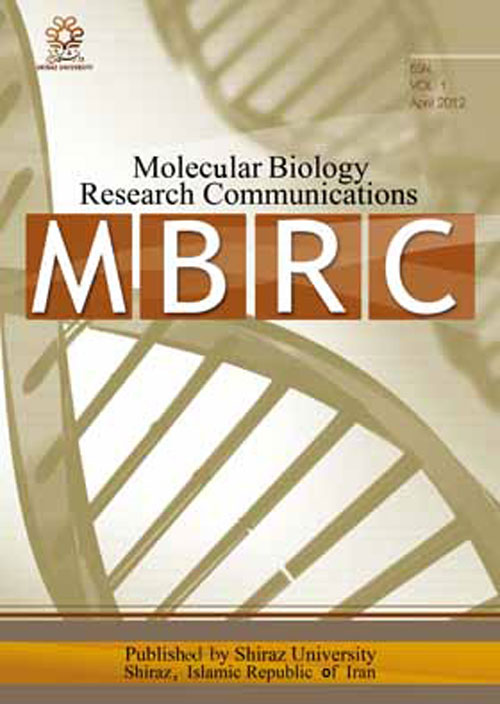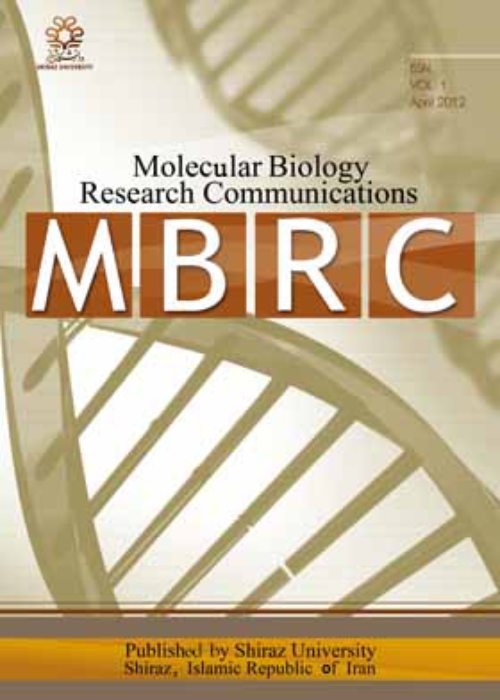فهرست مطالب

Molecular Biology Research Communications
Volume:11 Issue: 3, Sep 2022
- تاریخ انتشار: 1401/08/01
- تعداد عناوین: 5
-
-
Pages 113-118About 60-80% of thyroid cancer (TC) cases are papillary thyroid cancer (PTC). Studies have shown that serum adiponectin levels are inversely related to the risk of TC and PTC. Aim of the present study was to evaluate the association between adiponectin rs2241766 and rs266729 polymorphisms and risk of PTC. 122 PTC patients and 128 healthy subjects were enrolled in the study. PCR-RFLP and ARMS-PCR methods were used for genotype analysis. The rs266729 polymorphism did not correlate with risk of PTC. As regard rs2241766 polymorphism, the frequency of the GG genotype did not have a significant difference between the two groups, although, PTC cases showed higher frequency of GT genotype compared to controls (OR=2.87, 95% CI=1.56-5.28, P=0.001). We observed a significant association between adiponectin rs2241766 polymorphism and PTC, however, our result showed no significant relationship between adiponectin rs266729 polymorphism and risk of PTC.Keywords: Adiponectin, Papillary thyroid cancer, Polymorphism
-
Pages 119-126
Recent studies have shown that the level of hepatocyte-derived mitochondrial DNA is elevated in plasma samples obtained from mice and NASH patients, and it has the ability to toll-like receptor 9 (TLR9) activation resulting in steatosis, hepatocyte injury, and fibrosis. In this study, we explored the association between TLR9 rs5743836, rs352140, and rs187084 polymorphism and its plasma mRNA level in non-alcoholic fatty liver (NAFL) patients with different liver fibrosis scores compared to healthy controls. Seventy Iranian patients diagnosed with NAFL, based on fibroscan testing results, were divided into F0-F1 (N=33), F2-F3 (N=19), and F4 (N=18) hepatic fibrosis groups and compared to 22 healthy controls. Genotyping was done using polymerase chain reaction-restriction fragment length polymorphism (PCR-RFLP) and the mRNA expression level of TLR9 was determined using Real-Time PCR analysis. Results showed no significant association between allelic and genotypic distribution frequency of TLR9 rs5743836, rs352140, and rs187084 polymorphisms in NAFL patients with hepatic fibrosis compared to healthy controls (P>0.05). However, the mRNA level of TLR9 was significantly elevated in correlation with hepatic fibrosis progression in NAFL patients compared to healthy controls (P<0.05). As a preliminary study, our data showed a correlative overexpression of TLR9 mRNA with hepatic fibrosis progression in NAFL patients without the effectiveness of TLR9 gene polymorphisms.
Keywords: Hepatic fibrosis, Non-alcoholic fatty liver, Polymorphism, Toll-like receptor -
Pages 127-131
B.bronchiseptica is pathogenic for some domestic and wild animals. Due to the importance of this bacterium, its presence in dogs and cats has been investigated using PCR. Pharyngeal and nasal swabs were taken from 135 dogs and 42 cats. Based on the PCR performed on the dogs' samples, in 25/63 (39.68%) pharyngeal samples and 20/59 (33.89%) nasal samples DNA of B. bronchiseptica detected. On the other hand, according to the PCR performed on the cats' samples, in 9/23 (39.13%) pharyngeal samples and 319 (15.78%) nasal samples DNA of B. bronchiseptica was existed. According to the present study, the rate of B. bronchiseptica infection is high among dogs and cats in Iran. Also, due to the fact that the prevalence of this bacterium among pets animals is not exactly known in Iran, necessary measures should be taken for rapid diagnosis and treatment and proper control of the infection.
Keywords: Bordetella bronchiseptica, Cats, dogs, PCR -
Pages 133-141
Papillary thyroid carcinoma (PTC) accounts for approximately 80% of all human thyroid malignancies. Recently, there has been a dramatic rise in the prevalence of thyroid cancer all over the globe. Through analysis of the GEO database, GSE104005, the authors of the current research were able to determine the differential expression of microRNAs (DEMs) as well as their target genes. Real-time PCR was used on a total of 40 samples, 40 of which were from PTC samples and 40 from normal tissues, in order to validate the discovered DEMs and the genes. Gene Ontology (GO) categories were identified, and KEGG was used to conduct pathway enrichment analysis. The multiMiR R package was used to predict target genes of DEMs. Mir-142 was found to be overexpressed in PTC samples, as compared to normal tissues, and this was validated by the identification and validation. In addition, metal ion binding and the cellular response to metal ions were identified as essential pathways in the carcinogenesis of PTC. This demonstrates their significance in the development of this malignancy. The results of our research will serve as the foundation for further research in the area of miRNA-based cancer treatment.
Keywords: Papillary thyroid cancer, MicroRNA, bioinformatics, Microarray data analysis -
Pages 143-153Enterococcus species are a long-standing and non-pathogenic commensal bacterium, representing an important part of the normal. Enterococcus durans is a rarely isolated species from animals and humans, and it was a tiny constituent of human oral cavity and animal intestinal flora, as well as animal-derived foods, particularly dairy products. This study evaluated the security of our strain E. durans NT21 by using whole-genome sequencing (WGS), physicochemical features, and antimicrobial activity. The complete genomic of our strain Enterococcus durans NT21was sequenced and analyzed by using several bioinformatics tools to identify bacteriocin genes, virulence genes, antibiotic resistance genes, Crispr-Cas and pathogenicity islands. The results showed that our strain NT21 lacks the presence of virulence genes, pathogenicity islands, plasmids and has only two antibiotic resistance genes. On the other hand, it produces three bacteriocin-like inhibitory substances (Enterolysin A, P and L50a). It has six gene-encoded Crisper-Cas and one cluster Crispr-Cas gene. According to our findings, E. durans NT21 is a possible probiotic strain that is safe for both human and animal use.Keywords: Whole-genomic sequencing (WGS), Enterococcus durans NT21, Probiotics, human oral cavity, Crisper-Cas


